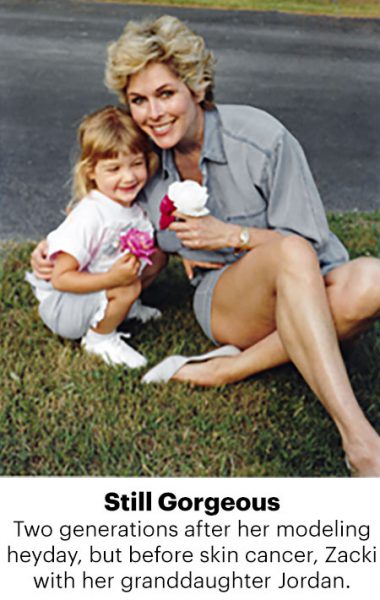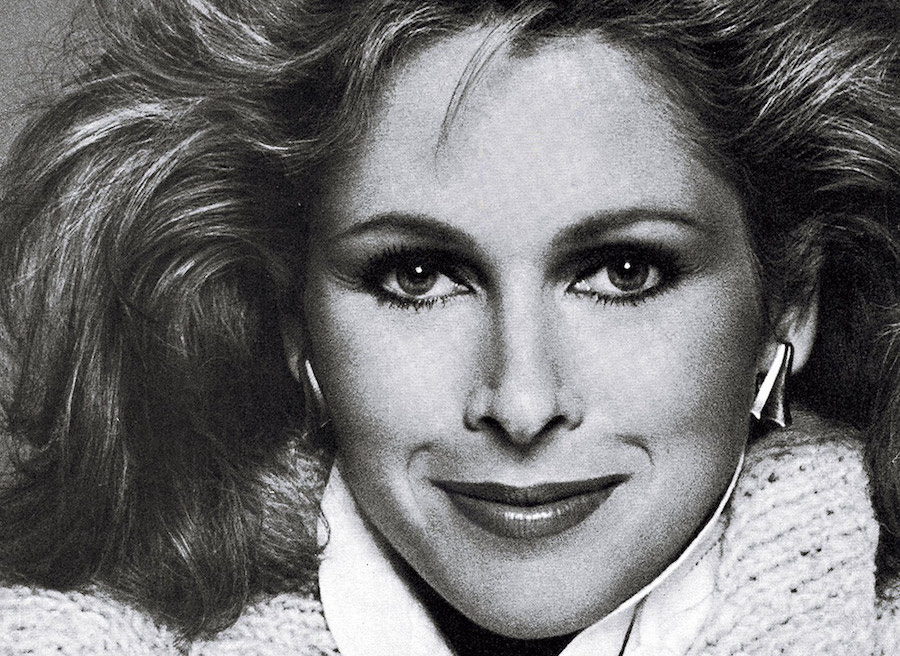She was a much-sought-after model, and her looks were her meal ticket. But when her clients asked her to “get a little color” for photo shoots, she never dreamed it would lead to skin cancer —and a disfiguring scar smack in the middle of, yes, her face.
By Zacki Murphy
In the morning light, my then beau, New York Giants running back Tucker Frederickson, turned for a kiss and paused. “You have a pimple!” he exclaimed. He might as well have said, “You have cancer!” I was an international Ford model, and his comment reverberated throughout my day, making me self-conscious during a Clairol booking. My face, hair and body were my paycheck. My skin had to be flawless!
The Pursuit of False Perfection
So imagine my alarm years later when, in June 2015, my dermatologist, Patricia Mauro, MD, at the University of North Carolina (UNC), did a biopsy of a suspicious spot on my nose and informed me that I had basal cell carcinoma. My head started spinning, and it took me a few seconds to process. Dr. Mauro immediately escorted me to the Mohs Center at the university hospital to meet Brad Merritt, MD, who would soon become my Mohs surgeon and skin sculptor.
My thoughts drifted back to summer days as a teen, spent at the pool swimming and smearing iodine and baby oil on my skinny frame to amplify the sun’s effects.”

In his office, my thoughts drifted back to summer days as a teen, spent at the pool swimming and smearing iodine and baby oil over my skinny frame to amplify the sun’s effects. Later, when I was a cheerleader at UNC, having bronzed limbs helped to set off the school colors, Carolina blue and white. A week before football season, we practiced cheers at the beach, and “Who has the darkest legs?” became our mantra. At the Tri Delta house, sunny days meant climbing onto our third-story roof to “work on our tans” without our greased bodies sliding into the gutters. All of this, it turns out, was sheer insanity for someone of Scotch-Irish descent like myself, with skin especially vulnerable to sun damage and prone to developing skin cancers.
Later, as a model, I was often encouraged to “get a little color” before assignments. For several years I did a Lilly Pulitzer campaign for Vogue called “Lilly Follows the Sun.” We shot in many exotic locations, including the active Kilauea volcano in Hawaii, where I had to walk in heels on a cold lava bed with glowing fissures below.
Other outdoor assignments, usually with scant sun protection, included skiing for Cosmo in Chile, wearing Arnold Palmer golfing outfits while hitting balls with the legend and playing tennis with Pancho Gonzales. Meanwhile, my agent Eileen Ford introduced me to George Hamilton, the ultimate “tan man.” When we dated in the late ’70s, we were never in the shade. George’s Rolls-Royce Corniche convertible top was always open, and he never went anywhere without his aluminum sun reflector. His parting words to me were, “I will always have a tan and look good.”
I don’t like admitting that once, in preparation for a UNC fashion show, I used my physician dad’s ultraviolet lamp to get color on my face. I read while under the lamp and ended up at the hospital in the middle of the night with burned eyes. Another time I lay in the Hawaiian sun before a date with Tom Selleck and was sunburned so badly that I needed double facials and an ice pack for my non-siliconed fat lips!
For years, Zacki was much in demand for magazines, doing covers for publications ranging from Hair Trends and Showcase to New York and McCall’s. Zacki modeled for countless cosmetics and grooming companies, such as Avon, Maybelline and Revlon. She served as an international spokesperson for L’Oréal.
I Did Not Dodge the Bullet to My Face
Decades later, I was paying the price. Dr. Merritt carefully examined my nose and scheduled surgery for the next week. He then explained the Mohs procedure in detail: After the surgeon removes tissue containing the cancer, the patient waits as the doctor analyzes it under a microscope to see if he took out all the cancer cells. If some part of the tissue still shows cancer, the surgeon removes more tissue from that area, and this is repeated until the patient receives the all-clear. It’s considered the most effective technique for removing many of the most common skin cancers, since it spares the greatest amount of healthy tissue while also completely eliminating the tumor.
Decades later, I was paying the price… Although the surgery had been successful, I let out a screech when I saw my face in the mirror.”
The challenge in my case: The cancer was not only growing, but it was right on the tip of my nose, smack in the middle of my face. I fearfully remembered a college professor who had a chunk of his nose missing thanks to skin cancer, and how distracting it was.
The surgery took place on June 16. When I was settled with my nose well numbed, the doctor removed a sizable amount of tissue. It took only 20 minutes, but then I had to wait two long hours to find out if the margins around the wound were clear of cancer. Fortunately, they were. Otherwise, I’d have had to go right back under the knife.
Next, Dr. Merritt repaired the wound, which looked a lot to me like a bullet hole. I did not want to watch, but after he was done, I let out a screech in the ladies’ room when I saw my face in the mirror. Although the surgery had been successful, that first glance was no picnic, as you can see in the photo below. My friend titled the photo, “Anne Boleyn after Beheading.”
In Hiding
 I didn’t know what to expect as I healed, but I dared not go anywhere lest dogs bark and children cry. For the first week, every time I coughed or sneezed it started a nosebleed. I stayed inside as my bandages turned vermilion. My swollen eyelids remained midnight blue in the middle of my jaundiced-looking face. I have no photos from that week, as I didn’t want to gross out anyone. Once again, I felt extremely self-conscious and basically hid out.
I didn’t know what to expect as I healed, but I dared not go anywhere lest dogs bark and children cry. For the first week, every time I coughed or sneezed it started a nosebleed. I stayed inside as my bandages turned vermilion. My swollen eyelids remained midnight blue in the middle of my jaundiced-looking face. I have no photos from that week, as I didn’t want to gross out anyone. Once again, I felt extremely self-conscious and basically hid out.
When I reported to Dr. Merritt after six weeks, the scab on my nose still embarrassingly prominent, he recommended dermabrasion—scraping or polishing down the damaged superficial skin layers with an abrasive tool.
I expected him to pull out some sophisticated motorized device, but no, it was sandpaper! After an injection to numb me, he scraped my nose with it to soften the scar perimeters. A week later, the bandages were gone and Dr. Mauro, my excellent dermatologist, did a biopsy on another “suspicious-looking place.” Declaring it a skin precancer, a growth that could turn into a full-blown cancer if left untouched, she sprayed liquid nitrogen, a freezing agent, on the spot, and the growth subsequently crusted and fell off. “You grow things,” she told me. I thought to myself, “Yes, well, I like to grow herbs and flowers, but not so much these ugly lesions.”
Lessons Learned
Unfortunately, once you suffer sun damage, and especially once you’ve had a skin cancer, your odds of developing future skin cancers go way up, so I will always have to be careful, practicing sun protection, checking my skin head to toe regularly and visiting my dermatologist two or more times a year to make sure we catch any new skin cancers early, when they’re easily curable.
 After 28 years as a professional model, I look back and think about the countless ads I did for beauty companies that “bought” my face as the example of how you might look if you used their products. What the public didn’t see was the sun damage I was doing to that face behind the scenes, not only at the behest of my employers but out of simple vanity and unawareness.
After 28 years as a professional model, I look back and think about the countless ads I did for beauty companies that “bought” my face as the example of how you might look if you used their products. What the public didn’t see was the sun damage I was doing to that face behind the scenes, not only at the behest of my employers but out of simple vanity and unawareness.
There is no such thing as perfection, but I now know that avoiding tanning and practicing sun protection are the best ways to keep your skin as perfect as possible for as long as possible. I’ve not only learned to wear sun-safe clothing, find shade and apply sunscreen whenever I go out, but I make these things a part of my daily rituals, as much as brushing my teeth and bathing.
Over the years, I worked with Avon, Cover Girl, Shiseido, Coty, Maybelline, Merle Norman, Revlon, Oil of Olay and so many other companies. One of my favorite gigs was serving as an international spokesperson for L’Oréal. Their slogan was “I’m worth it!” Well, so are you! Be aware that the sun is a wonderful and necessary part of our existence, but it is not our skin’s best friend. We used to associate being tan with being healthy, but now, with the sun’s rays more intense than ever, we know better. If you want a bronzed appearance, spray it on with a natural (non-UV) self-tanning product.
These days I find myself frequently on “autodial” to my dermatologist. I let her go over anything that seems a little unusual: bra-line bumps, old bikini demarcations. I’ve been zapped a number of times with that freeze gun, but this is and will be my routine for the rest of my life—because I “grow things.”
Even a skin cancer that is “just basal cell carcinoma” is an ordeal, and going through Mohs surgery is nobody’s idea of a party. The experience changed the appearance of my nose and opened my eyes to the reality of basal cell carcinoma. My nose is still healing and slowly getting better, but I’ll have to look over my shoulder the rest of my life for the skin cancer that could be gaining on me.
For now, what is important is that the cancer is gone — thank heavens!

*This article was first published in the 2016 issue of The Skin Cancer Foundation Journal.





